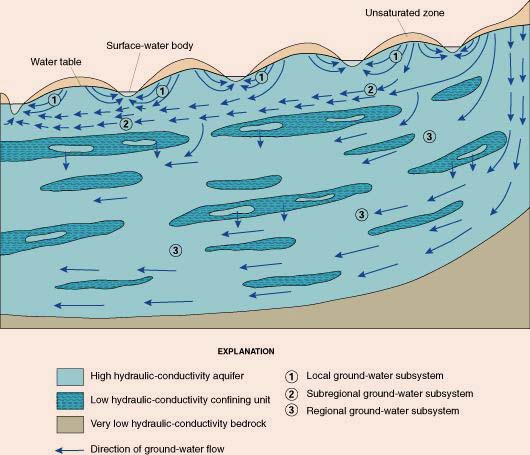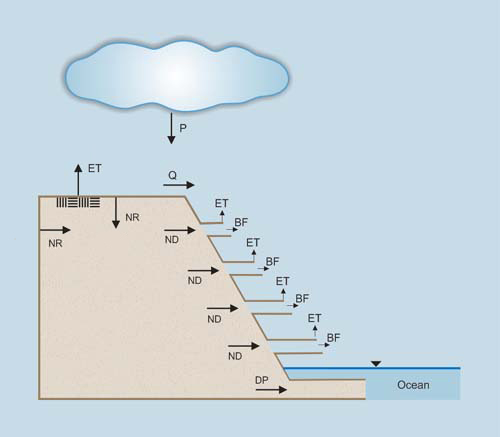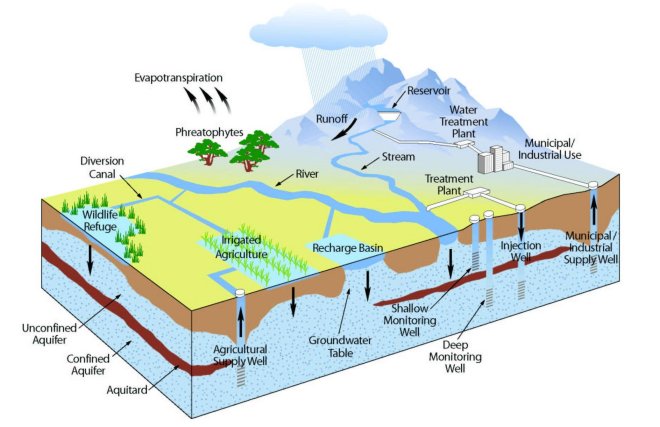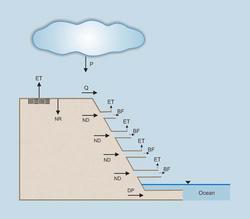|
• The relation between groundwater and surface water • 2010
|
♦ A difficult question ♦
The question of who owns the groundwater has no straightforward answer.
Currently, anybody who can pump the groundwater under his/her property effectively owns it.
However, in nature, groundwater is not a volume but a flow, and this flow is constantly moving from a place of recharge to a place of discharge.
Therefore, whoever sits at or near the place of discharge may have a claim on the groundwater which flows to that place of discharge. This
may be a lake, wetland, stream or river, or an ecosystem which depends on the [recharge to and] discharge from groundwater.
Taking a certain amount of groundwater through pumping and not returning it through recharge effectively encroaches upon the rights
of those who benefit from the natural discharge, be it flora, fauna, or humans. Thus, all groundwater of economic interest amounts to borrowed surface water;
eventually the groundwater would have to discharge into the surface waters. Therefore, the question is appropriate: Who owns the groundwater?

|
Fig. 1 Typical pattern and direction of groundwater flow.
♦ Groundwater capture ♦
All groundwater pumping comes from capture.
Within a control volume, capture comes from increases in recharge and decreases in discharge.
For the system as a whole,
any amount of capture effectively decreases natural discharge.
Thus, in theory, the optimum groundwater policy is a policy of no use. However, this situation imposes a
socioeconomic hardship on those who, over the years, have
come to depend on the groundwater which flows under their properties.
A policy of no use is unfeasible, even though it would be the most conservative.
The solution is to determine a sustainable "socioeconomic" yield, a practical value which represents a compromise between the conservative
policy of [little or] no use and the taking of all natural recharge, which amounts to the sequestering of all natural discharge.

|
Fig. 2 Geometric model of a groundwater reservoir.
♦ Sustainable socioeconomic yield ♦
Sustainable socieoeconomic yield seeks to strike a reasonable compromise between competing interests, in practice resolving the issue of who owns the groundwater.
Yes, groundwater may be pumped, but to a limit. This limit is to be imposed, not based on hydrogeologic considerations,
but on a reasonable compromise between
the rights of all stakeholders, including the rights of natural systems.
In practice, sustainable yield may be expressed as a percentage of natural recharge, even though in nature there is no relation between them.
Studies are needed on a local and regional basis to determine appropriate percentages. Initially, a sustainable yield equal to 10% of natural recharge is deemed to be reasonably conservative,
while higher values may reflect the need for a socioeconomic compromise. A value of 100%, which was accepted practice in the past, is no longer considered appropriate.
Increasingly, baseflow conservation is being taken as a measure against which to assess sustainable socioeconomic yield.

|
Fig. 3 Surface water and groundwater relations.
Reference: Ponce, V. M. 2007. Sustainable yield of ground water. Web report.
